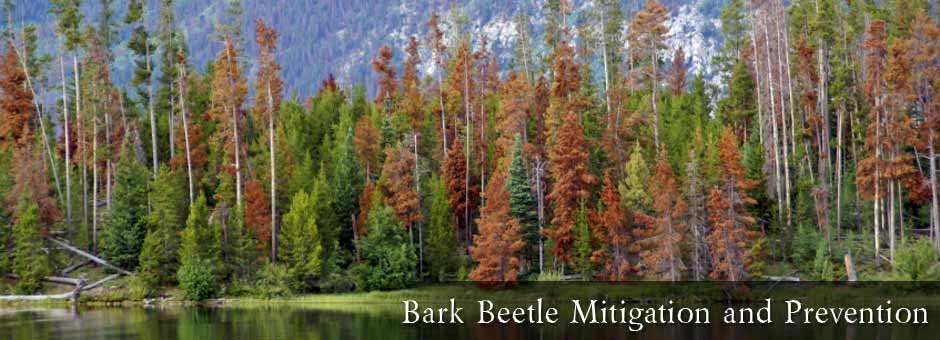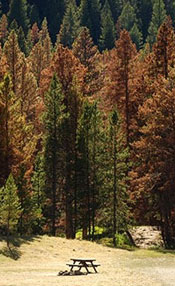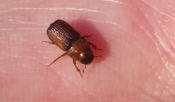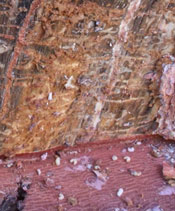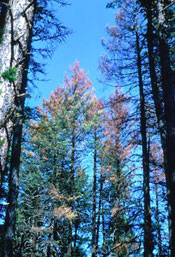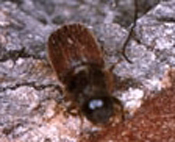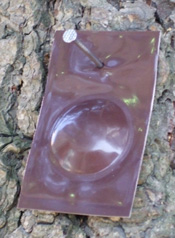The bark beetles of today’s western forests have physiologically evolved with the forests of the west. Bark beetles of the Western Conifer forest are an important component to forest regeneration. The bark beetle inhabits the same habitat as that of fire. The bark beetle prefers dense, overstocked forests where plants compete with one another for a limited amount of water, sunlight, and nutrients; therebye, resulting in a stressed forest.
Under the right circumstances, a fire would burn through the forest and regenerate the forested stands. However, we have had success in fighting fire over the last century, and we have largely prevented fire from entry into the forests of the West. The bark beetle is simply filling in the role that fire would otherwise play. Understanding that the role of the beetle is that of regeneration and not that of human enemy allows us to prescribe treatment to the forest. It is important for us to understand that the discoloration and the mortality that the beetle causes in our forests is only a symptom of a larger concern. The concern is restoring the forest to a healthier condition, and we should not lose sight that restoration is what our forested stands are demanding.
No chemical, regardless of how effective it is in combating beetle infestation will treat the core issue of restoration. The most comprehensive form of management involves the use of silvicultural treatment in combination with chemical and pheromone manipulation. By doing so, we are able to give the forest the functional regeneration it needs while also addressing the aesthetic demands of the forest landowner.
Prevention Strategies around your Home
| 1. PLAN. If you reside in an area with beetle activity, we recommend you plan your beetle management strategy by consulting with Firewise Landscapes Inc.Beetle activity can last for 3-5 years so a long-term strategy is best. An ounce of prevention is worth a pound of cure.2. REMOVE any infested trees well before the beetles emerge. Nothing good will come from leaving beetle infested trees in the area you are trying to protect. The trees should be disposed of through removal from the site to a safe distance away from the forest, through chipping, or through burning. Do this well in advance of the beetle flight (preferably do it in the fall). Remember that trees infested in the spring and summer will have adult beetles ready to emerge the next year and there will be many more emerging than went in. They will all be looking for new host trees to begin the reproductive cycle again.3. DO NOT PRUNE during the spring and summer months. Do not damage bark if possible. The scent of freshly cut wood is the primary attractant that draws beetles right to your trees.
4. WATER your “landscape trees” if possible. By “landscape trees”, we mean trees that are surrounding your home. It may not be practical to move throughout the forest individually watering trees; however, for those that you can water around the home, it may be worth your time. Keeping your tree healthy is the best beetle defense, as healthy trees have more “pitch” and can better defend themselves from beetle attack. This resin immobilizes the attacking beetle and ‘pitches’ it out. To ensure your tree has a good supply of pitch, keep it well watered, especially in times of drought. 5. SILVICULTURE – Thin your tree stand and promote a diversity of tree ages, classes, and types. A dense, overcrowded forest leads to competition between plants for valuable water, sunlight and nutrients. Determining harvest prescriptions is a site specific consideration. Contact Firewise Landscapes Inc. for more information. 6. DIVERSITY in your stand will keep your trees healthier. A species mix will reduce the risk to any given pest. Each tree species has different sun, water and nutrient requirements. Remember, the roll of the beetle is to speed up the normal decay of older, stressed trees to keep the natural ecosystem at it’s healthiest. 7. DIRECT CONTROL – Contact Firewise Landscapes Inc. to spray your trees with a insecticide, or apply Verbenone or MCH to reduce tree mortality on your property. . Good to Know: Once the first pioneer beetles land on a tree, they will send out a very attractive pheromone to invite other beetles into that direction. For this reason it is best to use direct control methods prior to beetle flight. |
|
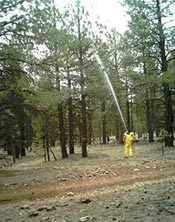 Spraying Infested Trees Spraying Infested Trees |
|
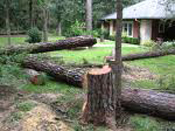 Remove Infested Trees Before the Beetle Flight Remove Infested Trees Before the Beetle Flight |
|
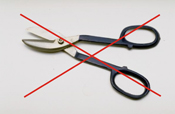 Freshly Pruned Trees are a Homing Beacon for Beetles Freshly Pruned Trees are a Homing Beacon for Beetles |
|
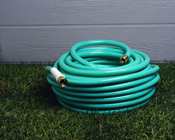 Water When Possible to Increase the Pitch in the Tree Water When Possible to Increase the Pitch in the Tree |
|
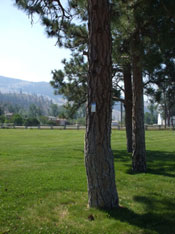 Verbenone on Tree Verbenone on Tree |
Mountain Pine Beetle Prevention with Verbenone
| Verbenone is used to help prevent attack of the Mountain pine beetle. Verbenone can also repel:Western Pine beetle – Dendroctonus brevicomisRed Turpentine beetle – Dendroctonus valens(These other beetles require different application strategies, so if you plan on using Verbenone for these beetles, please give us a call).NOTE: Mountain pine beetle will attack almost all species of pines and has recently been known to attack Jackpine/Lodgepole hybrids and Scotch pine.Verbenone is the anti-aggregation (repellant) pheromone used by the Pine beetle. Verbenone signals other pine beetles that they need to find another area to occupy because these trees are full. The beetles will move through a treated area and continue to fly until they find a suitable tree or die in the process.
How do I use Verbenone on my trees?Verbenone comes in a rectangular pouch roughly the size of a thin deck of cards. The Verbenone diffuses through the plastic membrane and is released into the surrounding area. The release rate is effected by the surrounding air temperature; the warmer the air the higher the elution rate. Wind speed and direction influence where the pheromone plume will go. Verbenone products are volatile chemicals and insects can only ‘sense’ these chemicals from a down wind position. Use the wind factor to your advantage, if possible. It is also important to note that Verbenone is good for the entire season and does not require a midseason lure change. Simply staple Verbenone to the north side of the tree, as high as you can reach. Contact Firewise Landscapes for more information. |
|
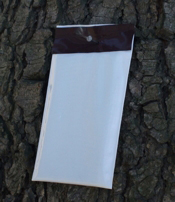 Verbenone on Tree Verbenone on Tree |
Douglas-fir Beetle Prevention with MCH
| MCH is used for protection of the following trees:-Douglas-fir trees-Spruce treesTo Protect Against:
-Douglas-fir beetle – Dendroctonus pseudotsugae -Spruce beetle – Dendroctonus rufipennisMCH is the anti-aggregation (repellant) pheromone used by the Douglas-fir beetle. The MCH signals other Douglas-fir beetles that they need to find another area to occupy because these trees are all full. The beetles will move through a treated area and continue to fly until they find a suitable tree or die in the process. How do I use MCH on my trees?MCH comes in small bubble roughly the size of a silver dollar. The MCH diffuses through the plastic membrane and is released into the surrounding area. The release rate is effected by air temperature; the warmer the air, the higher the release rate. The wind speed and direction determines where the pheromone plume will go. It is also important to note that MCH is a volatile chemical and insects can only ‘sense’ this chemical from a down wind position. Use the wind factor to your advantage, if possible. MCH is most effective when it is applied before the Douglas-fir beetles begin to fly and attack trees in the spring. This is usually in late April or early May in the Pacific Northwest and the northern Rocky Mountains. However, it is still effective in reducing further attacks even if used later in the season. Simply staple MCH to the north side of the tree, as high as you can reach. Contact Firewise Landscapes for additional considerations and consultation. Useful tip: If you plan on using MCH from one year to the next, clip a corner so you can tell which ones are from last year.
|
|
